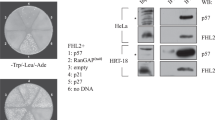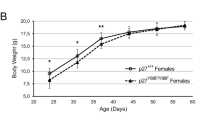Abstract
The 52-kD Activator Protein (AP2) is a DMA-binding transcription factor1–3 implicated in signalling terminal differentiation2–4. Profound developmental abnormalities have been recently observed in AP2-null mice5,6. The molecular events by which AP2 promotes differentiation or development are, however, unknown. Increased expression of the universal cell cycle inhibitor P21WAF1/CIP1 occurs in growth-arrested terminally differentiating cells7–12. In a search for cellular factors that could activate p21 during phorbol ester (TPA)-induced differentiation, we identified AP2 as a regulator of p21 expression. Mutagenesis of an AP2 DMA-binding site within a p21 promoter-luciferase reporter inhibited its activation by either AP2 transfection or TPA stimulation. Endogenous p21 protein levels were elevated and DMA synthesis was inhibited in AP2 versus control vector-transfected cells. Overexpression of AP2 in HepG2 human hepatoblastoma and SW480 human colon adenocarcinoma cells inhibited cell division and stable colony formation. These results link the differentiation-associated factor AP2 to negative cell cycle and growth control, possibly through p21 activation.
This is a preview of subscription content, access via your institution
Access options
Subscribe to this journal
Receive 12 print issues and online access
$209.00 per year
only $17.42 per issue
Buy this article
- Purchase on Springer Link
- Instant access to full article PDF
Prices may be subject to local taxes which are calculated during checkout
Similar content being viewed by others
References
Mitchell, P.J., Wang, C. & Tjian, R. Positive and negative regulation of transcription in vitro: enhancer-binding protein AP-2 is inhibited by SV40T antigen. Cell 50, 847–861 (1987).
Williams, T., Admon, A., Luscher, B. & Tjian, R. Cloning and expression of AP-2, a cell-type-specific transcription factor that activates inducible enhancer elements. Genes Dev. 2, 1557–1569 (1988).
Imagawa, M., Chiu, R. & Karin, M. Transcription factor AP-2 mediates induction by two different signal-transduction pathways: protein kinase C and cAMP. Cell 51, 251–260 (1987).
Luscher, B., Mitchell, P.J., Williams, T. & Tjian, R. Regulation of transcription factor AP-2 by the morphogen retinoic acid and by second messengers. Genes Dev. 3, 1507–1157 (1989).
Schorle, H., Meier, P., Buchert, M., Jaenisch, R. & Mitchell, P.J. Transcription factor AP-2 essential for cranial closure and craniofacial development. Nature 381, 235–238 (1996).
Zhang, J. et al. Neural tube, skeletal and body wall defects in mice lacking transcription factor AP-2. Nature 381, 238–241 (1996).
Michieli, P. et al. Induction of WAF1/CIP1 by a p53-independent pathway. Cancer Res. 54, 3391–3395 (1994).
Steinman, R.A. et al. Induction of p21 (WAF-1/CIP1) during differentiation. Oncogene. 9, 389–396 (1994).
Macleod, K.F. et al. p53-dependent and independent expression of p21 during cell growth, differentiation & DNA damage. Genes Dev. 9, 935–944 (1995).
Halevy, O. et al. Correlation of terminal cell cycle arrest of skeletal muscle with induction of p21 by MyoD. Science 267, 1018–1021 (1995).
Liu, M., Lee, M.H., Cohen, M., Bommakanti, M. & Freedman, L.P. Transcriptional activation of the Cdk inhibitor p21 by vitamin D3 leads to the induced differentiation of the myelomonocyticcell line U937. Genes Dev. 10, 142–153 (1996).
EL-Deiry, W.S. et al. Topological control of P21WAF1/CIP1 expression in normal and neoplastic tissues. Cancer Res. 55, 2910–2919 (1995).
Zeng, Y.X. & EL-Deiry, W.S. Regulation of P21WAF1/CIP1 expression by p53-independent pathways. Oncogene 12, 1557–1564 (1996).
Kharbanda, S. et al. Activation of Raf-1 and mitogen-activated protein kinases during monocytic differentiation of human myeloid leukemia cells. J. Biol. Chem. 269, 872–878 (1994).
Sato, E.F., Edashige, K., Inoue, M. & Utsumi, K. Okadaic acid increased annexin I and induced differentiation of promyelocytic leukemia cells. Biochim. Biophys. Acta. 1266, 23–30 (1995).
Williams, T. & Tjian, R. Analysis of the DNA-binding and activation properties of the transcription factor AP-2. Genes Dev. 5, 670–682 (1991).
Kannan, P. et al. N-ras oncogene causes AP-2 transcriptional self-interference, which leads to transformation. Genes Dev. 8, 1258–1269 (1994).
Gaynor, R.B. et al. Localization of the gene for the DNA-binding protein AP-2 to human chromosome 6p22.3-pter. Genomics 10, 1100–1102 (1991).
Trent, J.M. et al. Tumorigenicity in human melanoma cell lines controlled by introduction of human chromosome 6. Science 247, 568–71 (1990).
Foulkes, W.D., Ragoussis, J., Stamp, G.W., Allan, G.J. & Trowsdale, J. Frequent loss of heterozygosity on chromosome 6 in human ovarian carcinoma. Br J. Cancer 67, 551–9 (1993).
Nawroz, H. et al. Allelotype of head and neck aquamous cell carcinoma. Cancer Res. 54, 1152–1155 (1994).
Robertson, G.P., Coleman, A.B. & Lugo, T.G. Mechanisms of human melanoma cell growth and tumor suppression by chromosome 6. Cancer Res. 56, 1635–1641 (1996).
Somasundaram, K. et al. Repression of a matrix metalloprotease gene by E1A correlates with its ability to bind to cell type-specific transcription factor AP-2. Proc. Natl. Acad. Sci. USA 93, 3088–3093 (1996).
Buettner, R. et al. An alternatively spliced mRNA from the AP-2 gene encodes a negative regulator of transcriptional activation by AP-2. Mol. Cell. Biol. 13, 4174–4185 (1993).
Sherr, C.J. & Roberts, J.M. Inhibitors of mammalian G1 cyclin-dependent kinases. Genes Dev. 9, 1149–1163 (1995).
Hyman, S.E., Comb, M., Pearlberg, J. & Goodman, H.M. An AP-2 element acts synergistically with the cyclic AMP- and phorbol ester-inducible enhancer of the human proenkephalin gene. Mol. Cell. Biol. 9, 321–324 (1989).
Duan, C. & Clemmons, D.R. Transcription factor AP-2 regulates human insulin-like growth factor binding protein-5 gene expression. J. Biol. Chem. 270, 24844–24851 (1995).
Bosher, J.M., Williams, T. & Hurst, H.C. The developmentally regulated transcription factor AP-2 is involved in c-erbB-2 overexpression in human mammary carcinoma. Proc. Natl. Acad. Sci. USA 92, 744–747 (1995).
Timchenko, N.A., Wilde, M., Nakanishi, M., Smith, J.R. & Darlington, G.J. CCAAT/enhancer-binding protein a (C/EBPa) inhibits cell proliferation through the p21 (WAF1/CIP1/SDI-1) protein. Genes Dev. 10, 804–815 (1996).
Chin, Y.E. et al. Cell growth arrest and induction of cyclin dependent kinase inhibitor p21 WAF1/CIPI mediated by STAT1. Science 272, 719–722 (1996).
EI-Deiry, W.S. et al. WAF1, a potential mediator of p53 tumor suppression. Cell 75, 817–825 (1993).
Kastan, M.B. et al. A mammalian cell cycle checkpoint pathway utilizing p53 and GADD45 is defective in ataxia-telangiectasia. Cell 71, 587–597 (1992).
Author information
Authors and Affiliations
Rights and permissions
About this article
Cite this article
Zeng, YX., Somasundaram, K. & El-Deiry, W. AP2 inhibits cancer cell growth and activates p21WAF1/CIP1 expression. Nat Genet 15, 78–82 (1997). https://doi.org/10.1038/ng0197-78
Received:
Accepted:
Issue Date:
DOI: https://doi.org/10.1038/ng0197-78
This article is cited by
-
Epigenetically modified AP-2α by DNA methyltransferase facilitates glioma immune evasion by upregulating PD-L1 expression
Cell Death & Disease (2023)
-
ACTL6A suppresses p21Cip1 tumor suppressor expression to maintain an aggressive mesothelioma cancer cell phenotype
Oncogenesis (2021)
-
BMP6 Regulates Proliferation and Apoptosis of Human Sertoli Cells Via Smad2/3 and Cyclin D1 Pathway and DACH1 and TFAP2A Activation
Scientific Reports (2017)
-
Detection of four polymorphisms in 5′ upstream region of PNPLA2 gene and their associations with economic traits in pigs
Molecular Biology Reports (2016)
-
Motif co-regulation and co-operativity are common mechanisms in transcriptional, post-transcriptional and post-translational regulation
Cell Communication and Signaling (2015)



